What Are Chromosomes?
Cracking the Code: A Comprehensive Overview of Chromosomes and Their Function in Genetics
What Are Chromosomes? We have four terms: chromosome, base pair, genome, and gene. Can you define each one and then rank them from largest to smallest?
Different Types of Cells
There are different types of cells. In prokaryotic cells, like bacteria, there is usually one chromosome, a single loop of DNA located in the nucleoid region.
In eukaryotic cells, like human, plant, and fungi cells, chromosomes are found inside the nucleus. These chromosomes often look like X-shaped structures when viewed closely. These X shapes are actually sections of DNA organized in a way that’s easy to use.
Chromosomes and Encyclopedia Analogy
Think of chromosomes like sections in an encyclopedia. Instead of one massive book, the information is divided into smaller, more manageable sections, making it easier to read and copy.
Chromosomes are like these sections, containing parts of a larger information set called the genome. We inherit two genomes, one from each parent, making us diploid.
Zooming In
At the largest level, the genome includes all the genetic information inside a cell. Most of this information is in the chromosomes inside the nucleus, but there is also some in the mitochondria of animal cells and in the mitochondria and chloroplasts of plant cells.
A chromosome has a characteristic X shape when duplicated. The centromere in the middle holds the two sister chromatids together. During interphase, the DNA duplicates, creating identical information on both sides.
DNA Packaging
DNA in the nucleus is tightly packed to fit inside. If stretched out, the genome in a cell would be about 3 meters long. The DNA wraps around histone proteins to form nucleosomes, like beads on a string. Eight histone proteins envelop DNA to form each nucleosome.
Genes and Base Pairs
Zooming further into the DNA, we see the double helix structure. A portion of DNA called a gene codes for a particular protein. Humans have about 20,000 genes. Between these genes are regulatory regions that turn genes on or off.
The smallest units of DNA are the base pairs: Thymine and guanine pair with adenine and cytosine, respectively. These base pairs code for amino acids, which make proteins, which in turn make us.
Review
Let’s rank the terms from largest to smallest:
- Genome: All genetic information, including that in mitochondria and chloroplasts.
- Chromosome: are segments of the genome.
- Genes: Chromosome segments that encode proteins.
- Base Pair: The building blocks of genes.


